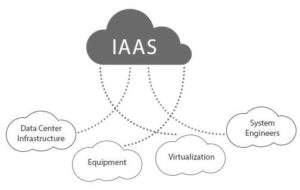Infrastructure as a Service reached its popularity in the early 2010s, and since that time, it has become the standard delivery model for various projects.
IaaS is about providing fundamental computing, network, and storage resources over the Internet on a pay-as-you-go basis. In comparison with other software delivery models, it gives the lowest-level control of the resources in the cloud.
What are the other peculiarities of IaaS? How can it benefit businesses? Keep reading, and you’ll find the answers right there.
Contents
IaaS definition: What does Infrastructure as a Service mean?
Infrastructure as a Service (IaaS) is a cloud computing service model that implies delivering computer infrastructure to support companies’ operations on an outsourced basis. You can also find the term HaaS (Hardware as a Service) that has the same meaning as IaaS.
Usually, infrastructure as a service covers the delivery of hardware, related services, and the data center space. Yet, it can also include software.
To avoid confusion in abbreviations, it is worth recollecting other cloud models that we have recently described:
- SaaS, aka Software as a Service, is a cloud computing service that utilizes Internet opportunities to deliver apps that are managed by a third-party representative. Most Software-as-a-Service products run directly through the web browser.
- PaaS, aka Platform as a Service, implies providing cloud components for building certain software. PaaS offerings have a framework for the development team to create custom apps.
Popular examples:
- SaaS: Dropbox, Google Apps, Cisco WebEx, Salesforce.
- PaaS: Windows Azure, Force.com, Heroku, Google App Engine.
- IaaS: AWS (Amazon Web Services), Linode, DigitalOcean, Rackspace.
Key aspects of IaaS delivering
Infrastructure as a Service offers cloud computing infrastructure, including operating systems, networks, servers, and storage facilities. Businesses typically access these servers through a dashboard or an API, and the customers of IaaS get complete control over the whole infrastructure.
Such solutions provide the same technologies and possibilities as traditional data centers without the need to manage them physically. Consumers can still access their servers and storage directly. However, it is all outsourced through a virtual cloud data center.
IaaS customers can manage applications, runtime, middleware, and data (unlike in SaaS or PaaS solutions). In their turn, IaaS providers are responsible for the servers, virtualization, hard drives, networks, and storage.

How IaaS benefit companies?
Here’s the list of IaaS key advantages:
- Reduced costs. IaaS eliminates capital expenses and excludes the upfront expense of managing an on-site data center. It is rather economical for startups that are testing new ideas.
- Speed. IaaS users can provide small or vast amounts of resources in minutes, testing new ideas quickly or scaling proven ideas faster.
- Scalability. It is easy to move from one instance of an app or workload to many, with seemingly limitless capacity and the ability to scale up resources automatically or with supervision.
- Availability. The availability of cloud apps can exceed traditional approaches thanks to such things as multizone regions.
- Latency. Considering the broad geographic footprint of most IaaS providers, it’s possible to put services closer to your users, reduce latency, and improve performance.
- Focus on the key business. Infrastructure as a Service allows teams to concentrate on the main company’s business rather than on IT infrastructure.
- Advanced security. An IaaS cloud service provider may ensure high security of your apps and data that may be better than what you can attain in-house.
IaaS for different workloads
There are four broad reasons for the popularity of IaaS apps and services:
- Digital business. Nowadays, digital solutions are required in many domains, including e-commerce, digital marketing, customer resource management, data services, and IoT.
- Agile project management. IaaS products help companies to implement and perform rapid application development, prototyping, experiments, and other projects that require agility.
- Substitution of the data center. Many businesses use IaaS instead of traditional on-premises data center infrastructure.
- Batch computing. This is the most common IaaS usage when it serves as a substitute for traditional high-performance or grid computing. Such apps include video encoding, rendering, genetic sequencing, numerical analysis, modeling and simulation, and data analytics.
Despite the advent of new technologies and computing models (containers and serverless) and the rise of the microservices application pattern, IaaS still remains popular and in high demand while existing in a more crowded field than ever.
Do you have your own experience of implementing IaaS solutions? How do you find them? Feel free to share your thoughts below!





